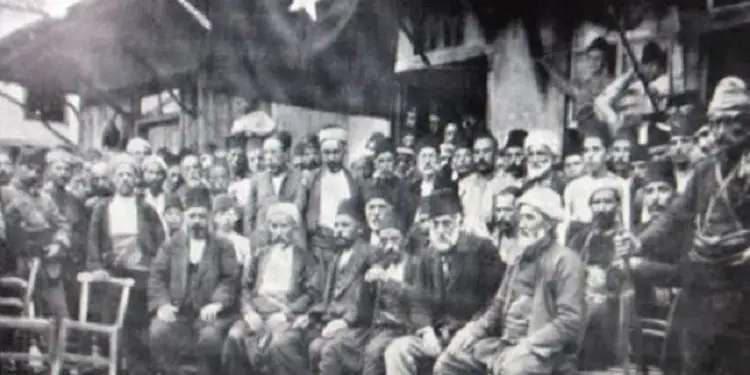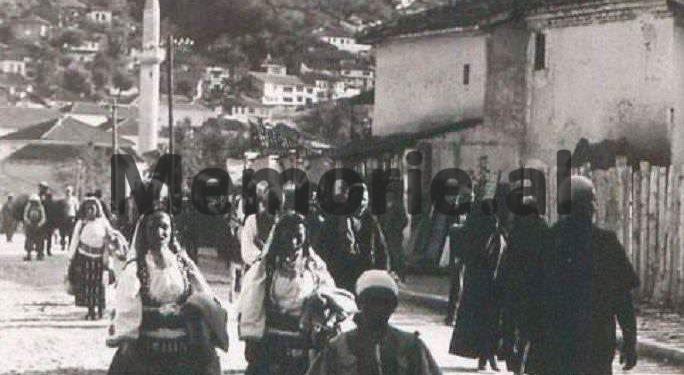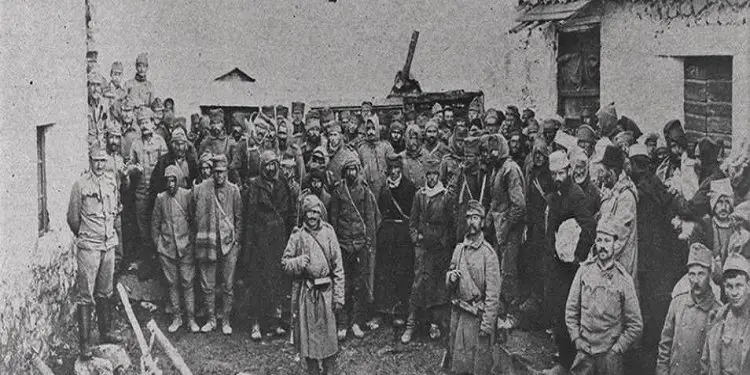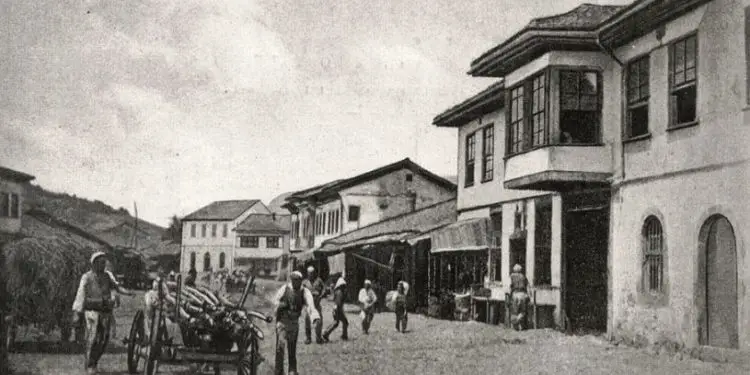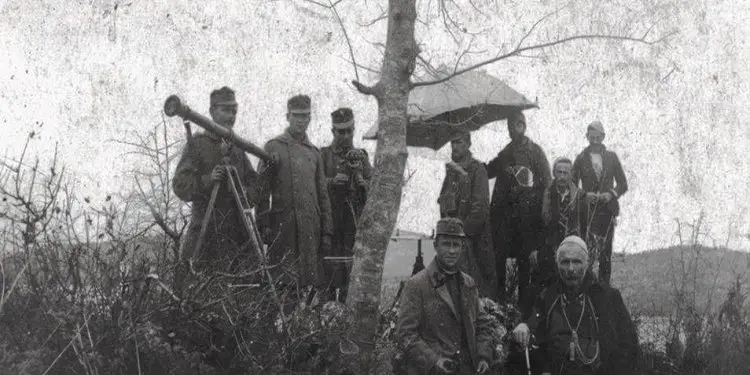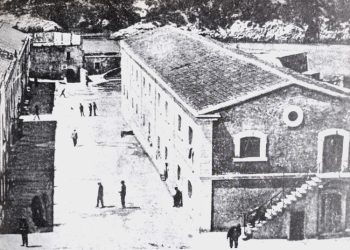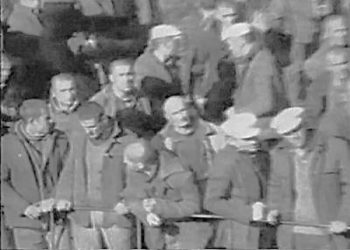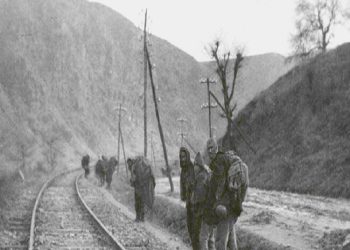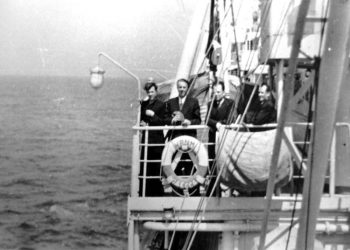From Bashkim Trenova
Part eleven
ALBANIANS ACCORDING TO THE SERBS
(THE EASTERN CRISIS AND THE BALKAN WARS)
Memorie.al / “Serbs are descended from the Slavs, a large number of tribes who gave life to the Slavic peoples. Knowledge about the origins of the history of the Slavs is modest and not so clear. Their name appears for the first time in the 6th century AD, when Byzantine writers start talking about the Slavs….”! (Dushan Bataković, Milan St. Protic, Nikola Samardžić, Aleksandër Fotic. History of the Serbian People. L’Age d’Homme. Lausanne. 2005. Pg. 3.)
Continues from last issue
Nikolla Samarxhic – historian, professor of the University of Belgrade:
The great emigration, three hundred years ago, hit them so hard that they never recovered. This was the beginning of the explosion of the Albanians in Kosovo and Metohija and the surrounding regions, as well as the expulsion of the Serbs from the heart of their former empire. To this day, this devastating explosion remains the most serious and the most dangerous on the part of Islam in Europe. The savagery of Albanian customs, their fantastic ability to reproduce, the former support from the Ottomans and today’s support from myopic Europe, have expelled the Serbs from their hearths. (1)
1 – Nikolas Miletic. Politique étrangère. The Serbian Orthodox Church. (Foreign policy. Serbian Orthodox Church). Perseus. Year 1996 (61-1). Pg. 191-192.
2 – Nikola Mirkovic. Serbia: les fractures active de la guerre. Conflicts. 24.02. 2020.
****
Petar Vlahovic – professor of the University of Belgrade, academician, ethnologist and anthropologist:
In the feudal era, many Slavs, living in Albania, were forced to join the Albanian community gradually, by force, while many others immigrated to other regions. These immigrants settled in the regions of Polog, Dibra, Manastir and Prespa, maintaining further ties with their parents, who did not leave and became Albanians. (2)
****
Predrag Pavlović – colonel of the APJ and long-time lecturer of national and military history at the Military Academy in Belgrade:
1 – Nikola Samardzic. Velika Seoba 1690, in P. Pejanovic (publisher). The great Serbian migrations from the 14th century to the 20th century: collection of works dedicated to the three hundredth anniversary of the Great Migration of the Serbs. Belgrade Zavod za udzbenike i nastovana sredsta: 1990, pg. 60.
2 – Petar Vlahovic. “Stanovništvo slovenskog svetnogo u Albaniji” – Zbornik radova sa mednogogo nauchnog skupa skupa na Cetinju 21, 22. i 23. juna 1990. godine. Rastko-Skadar project. Biblioteka Slovena u Albaniji i albansko-slovenskih cultural eggs. (Slavic population in Albania in the light of ethnological science. Sources: “Population of Slavic origin in Albania” – Proceedings of the International Scientific Conference held in Cetina on June 21, 22 and 23, 1990. Rastko-Shkodër project. Slavic library in Albania and Slavic-Albanian cultural ties.)
After the annexation of Bosnia-Herzegovina and the Young Turk Revolution, the idea of the Balkan Alliance and the protection of Serbian interests in the area occupied by the Turks were transferred to the institutions of the system. Important talks took place in the National Assembly of Serbia, in particular by Stojan Novakovic, who spoke for the Alliance. The problem was particularly aggravated after the Young Turk Revolution in 1908, as the position of Serbs and other non-Turkic peoples deteriorated significantly.
Chauvinism flourished, religious and school autonomy was removed, associations and national gatherings were banned. This situation led to anarchy and rebellion, especially of the Albanians, which the old authorities used to weaken the power of the Young Turks, and in this mess, mainly non-Turkish peoples, (read) Serbs were killed. (1)
—
After the Battle of Kumanovo, Serbia became an important factor in the Balkan Peninsula. It showed what Europe had not been able to see for centuries. The Serbs were freed by their own forces without anyone’s help. (2)
****
Radmila Marinković – historian of literature, specialist in medieval Serbian literature:
The feats of arms of Prince Lazar and the heroes of Kosovo (1389) will inspire a whole cycle of poetic compositions. The descendants of Lazar will try to preserve the organization of the Serbian state based on the tradition of the Nemanjic dynasty. In the courtyard, as in the past, poets will appear who, through the character of the hero, shed light on the situation and the ideological foundations of the Lazarevic dynasty. The new dynasty, for its part, creates its own saint. He is a hero of a new type, the sovereign who has to his credit only one achievement, only one battle. A battle that, for
1 – Predrag Pavlović and Novica Pešić (journalist and publicist). Srbima zulum dojadio. Les serbes en ont assez de l’oppression. (Serbs can’t stand oppression anymore). Nemanja. 06/10/12. Pg. 2.
2 – Predrag Pavlović and Novica Pešić. Warranty iz London. (Garanties de Londre- Guarantee from London). Nemanja. 22. 02. 2013. Pg. 2. Rather, he lost it, but in which he fell as a knight, defending Christian civilization. It embodies the identification of faith with the homeland, the endless connection with the Christian ideal, which also encourages self-sacrifice, the superiority of the spiritual over the material, of the heavenly empire over the earthly one. But the hero is not only the Christian prince.
The knights who accompany him in death are also great. They are the champions of loyalty to the sovereign, the guarantors of the sense of honor, of duty. This philosophy of duty is transmitted by the sovereign to all participants in the battle for Kosovo. Nemanja’s theory about the exercise of power is spread to all those who participate in the feudal military order and who must protect the faith, the people, the land.
What was achieved in Fushë Kosovo originates from the martyrdom of the first Christians, from the history of their suffering. It is a test that rises to the height of God’s elect, the saints. The writings about Prince Lazarus, in the form of praise, are composed in an epic, lyrical mood and have a strong emotional charge. Sensibility replaces the grandeur of earlier biographies, compassion replaces admiration; there is no joy, all is sadness, contentment, everywhere prevails the sweet peace of mind born of the intimate conviction to act as one should. This noble poem is one of sacrifice and moral victory.
It is based on the magnificent work [Povesno slovo] after the battle, by Patriarch Danilo III, in the very pure style called “pletenie sloves” (“letter embroidery”). His work contains all the elements of the theme of Kosovo, which will be developed later, and of the myth of Kosovo, which will be sung by oral poetry. The Kosova theme is the first remarkable example that has been preserved of the symbiotic relationship that existed between the two Serbian poetic systems in the middle Ages: oral and written. (1)
1 – Radmila Marinkovic. La literature serbe du Moyen Age. (Serbian literature in the middle Ages). Serbia. No. 2-3. March-June 2013. See also – «Средјевековна къжевност», in История српске културе [Histoire de la culture serbe], Belgrade, 1994. Pp. 53-66.
****
Radmilla Radiç – historian:
In a text entitled “The light that comes to us in Kosovo”, the archpriest Bozhidar Mihaç explained what Kosovo is for the Serbs with the words: “Kosovo is not only a place of rest, but also a metaphysical creature. Heaven and Earth have created this Serbian homeland. This is the indisputable reality of the soul in the phenomenon of time and space. This is the best proof that to determine the belonging of a land, one should not only look at the numerical, dominant composition of the population, which is essential, but also, and perhaps even more, one should look at the spiritual creatures that the people have produced and in which there is certainly a superior existential world. Ideo-genesis is in this case more important than ethnogenesis”. (1)
—
Bishop Jovan of Sabac-Valjeva uses the term: “heavenly Serbia”, which will be used often later. “Since the time of Prince Lazar and Kosovo, the Serbs will create, first of all, a heavenly Serbia, which has become today, without a doubt, the largest heavenly state. If we take only the innocent victims of the last war, millions and millions of Serbs, men and women, children and old people, killed and tortured in the worst sufferings, one can imagine the extent of the Serbian empire in today’s skies. (2)
****
Radosav Stojanovic – writer, journalist and lexicographer:
1 -Radmilla Radic. L’Eglise et la question serbe. (The Church and the Serbian Question). Les Editions de l’Atelier/éditions Ouvrieres, Paris, 1998. Pg.141.
2 – Right there. Pg. 147.
Many of my Kosovar Albanian friends have told me that, in any case, they don’t really have a state, that they are just a tool in someone else’s hands and that they must be obedient. And what kind of state could they have when it is known that this “thousand-year-old” nation has no cultural monuments older than 70 years, that it has a developed vassal mentality; there is no economy, except for the transit of drugs and crime. Everything that works is under the care of the international community, which exercises constant observation and control. I’d say it’s actually about controlled chaos and helplessness. (1)
****
Radoslav Gačinović – research associate at the Institute of Political Studies in Belgrade:
This is how Kosovo has been woven into my mind and consciousness since the beginning: as a fulcrum on which the planet rests in space, the Albanian terrorist movement since the end of the nineteenth century has chosen a strategy of violence against the majority of the Serbian population. The intensification of Albanian violence against the Serbs began after the establishment of the League of Prizren on June 10, 1878 in Prizren. The national movement and the idea of the ethnic union of Albanians were born immediately after the Congress of Berlin, in which it was decided that Turkey should withdraw from most of the territories of the Balkan Peninsula.
The League of Prizren is the founder of the idea to create an ethnically pure Greater Albania. Immediately after its formation, the First League of Prizren, with the help of Turkey and Austria, sheds light on its goals. Greater Albania was the main goal of the First League of Prizren. The violence against the Serbian population from the formation of the first League of Prizren until 1912 (when Old Serbia was liberated) was more pronounced than in the previous hundred years.
This is best seen from the correspondence of the Serbian consuls Spalajković, Nushič, Rakić and others in Pristina, as well as from the protest notes of the Kingdom of Serbia in Constantinople, which demand the protection of the population considered as a permanent threat to the national interests of the Arbanians. In 1881, Turkey forcibly broke with the League, whose radical wing sought to create an independent state that would prove to Europe that it was capable of implementing reforms. Despite this, in the following decades, Arbanasi took a special place in the system of Turkish rule in the Balkans.
The religious and ethnic intolerance of the Albanians towards the Serbs acquired a new political content: the strategic goal of the Albanian national policy was the systematic expulsion of the Serbs of these villages. The sultan’s policy of securing a new frontier with Serbia through the chain of Arban settlements and for the Arbans, as fanatics of Islam, to suppress all unrest by Serbs and other Christians in the European provinces of the Empire, returned Kosovo and Metohija in a bloody battlefield, where the sufferings of the Serbs were increased. From 1876 to 1883, about 1,500 Serbian families fled from Kosovo and Metohija as a result of oppression by the Arbanians in Serbia.
1 – Radosav Stojanovic. Kosovo is a very busy city. (Kosovo is a great suffering). Jedinstvo. 19. 07. 2015.
Despite this, in the following decades, Arbanasi took a special place in the system of Turkish rule in the Balkans. The religious and ethnic intolerance of the Albanians towards the Serbs acquired a new political content: the strategic goal of the Albanian national policy was the systematic expulsion of the Serbs of these villages. The sultan’s policy of securing a new frontier with Serbia through the chain of Arban settlements and for the Arbans, as fanatics of Islam, to suppress all unrest by Serbs and other Christians in the European provinces of the Empire, returned Kosovo and Metohija in a bloody battlefield, where the sufferings of the Serbs were increased. From 1876 to 1883, about 1,500 Serbian families fled from Kosovo and Metohija as a result of oppression by the Arbanians in Serbia. (1)
****
Radovan Samardžič – historian, director of the Institute of Balkan Studies at the Serbian Academy of Sciences and Arts:
Kosovo with the neighboring regions was the center of Serbian Orthodoxy and the most solid key point of this people. These provinces thus entered history. First, for the Serbian people, the foundation of the legend of Kosovo was, without any doubt, the grand and solemn idea that he had for Kosovo as the heart of the Serbian Empire, where his greatest spiritual and material wealth was located.
All the enemies of the Serbian people thought that they would cut off his head; they would tear it apart, make it powerless and alienate it if they managed to destroy it and take Kosovo. Regardless of the successes of their enemies, the Serbs, in the deepest depths of the abyss, found themselves again and went to war in order to create the conditions to continue living with dignity, being inspired by the legend of Kosovo.
This people, educated with the teachings of St. Sava, with the former imperial rules, formed in time, more and more connected with its self-governing institutions, this people over the centuries has fought incessant wars to survive, and always has envisioned its future as a continuation of its historical traditions. Kosovo was the most active core of such active determination. (1)
1 – Radoslav Gacinovic. Prva Prizrenska Liga kao putokaz politiçkog vizili nad serbima u staroj Srbiji. (The First Connection of Prizren as a policy guide against the Serbs in Old Serbia.) VOJNO DELO, 3/2019. Pg. 331 -334.
—
Among others, this was the era of the forceful entry of Albanians onto the stage of history. Pushed and set in motion, they organized gangs which, for robbery, dispersed in unexpected directions, as far as Belgrade, Vidin and Plovdiv, and even further.
Among the bandits, the Albanians occupied the first place. Some tribal or gang leaders would send their troops at night to attack villages, sow panic and terror, burn houses, kill and imprison or kidnap cattle. (2)
—
The union of the Albanian leaders from 1878 to 1881, with the aim of forming an Albanian League with bloody threats to Serbia and Montenegro, was not done without the knowledge and influence of the Turkish authorities; but immediately afterwards the High Gate ordered this movement to be suppressed. (1)
1 – Radovan Samardzic, Sima M. Cirkovic, Olga Zirojevic, Radmila Trickovic, Dushan T. Batakovic, Veselin Djuretic, Kosta Cavoski, Anatasije Jevtic. Le Kosovo-Metohija dans l’histoire serbe. (Kosovo-Metohija in Serbian history.) Slavica. L’Age d’Home. Lausanne 1990. Pg. 9.
2 – Right there. Pg. 15-16.
—
However, the adaptation of the Serbs was more pronounced in Kosovo. Adapting to the Albanian environment, they practically changed everything over time: their houses, the few possessions they had, their clothes, their behavior, even their appearance, they tried to make the owners of the house speak two or three languages that were used, they they hid icons and antiquities in the ceilings.
In addition to the forced or voluntary change of religion, adaptation, as well as the abduction of women, constituted one of the sure ways for their Islamization and assimilation by the Albanians…. As far as the historical data can be turned into a percentage, it can be it is said that 30-40% of the Albanians of Yugoslavia are of direct Slavic origin. Likewise, the data extracted from anthropo-geographical and historical research show that about 150,000 refugees left Kosovo-Metohija in a broad sense in the years 1878 and 1912, to move to Serbia. Memorie.al
The next issue follows




